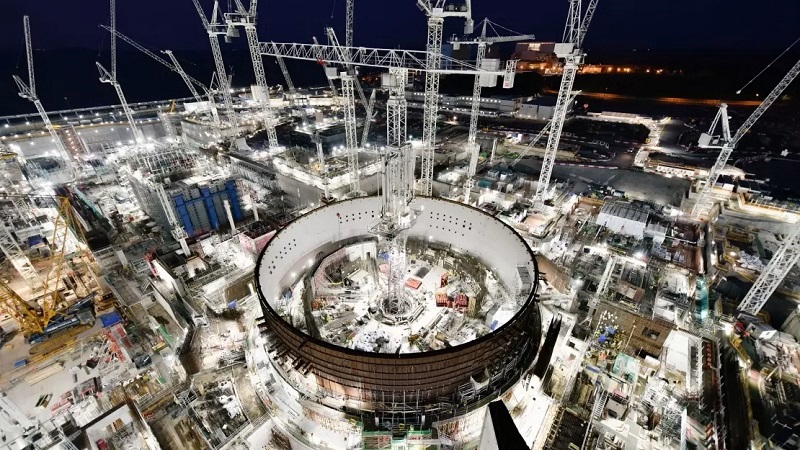The UK government has revealed a long-awaited strategy to meet its 2050 net zero emissions goal.
The 368-page document was published on Tuesday alongside a Treasury review of how to pay for the transition, less than two weeks before the UK welcomes world leaders to the start of the Cop26 climate talks in Glasgow.
In a foreword, prime minister Boris Johnson said the UK will “unleash the unique creative power of capitalism to drive the innovation that will bring down the costs of going green”.
“We set an example to the world by showing that reaching net zero is entirely possible, so the likes of China and Russia are following our lead with their own net zero targets, as prices tumble and green tech becomes the global norm,” he wrote.
The policy package is a test of the UK’s credibility as it pushes other nations to step up their climate ambition and commit to net zero emissions ahead of the Glasgow summit.
It includes investment in carbon capture and storage, hydrogen technologies and nuclear energy, an end to sales of gas boilers by 2035 and targets for manufacturers to deliver net zero vehicles.
‘Breakthrough’: IMF develops fund to help debt-laden nations address climate risks
Analysts welcomed the plan, but said more public investment would be needed to put it into action.
Chris Venables, head of politics at the Green Alliance, told Climate Home News: “It’s a real boost for UK climate leadership ahead of Cop26 but the jury is out on whether this genuinely closes the gap. The questions around the scale of funding throw serious doubt on that.”
The UK was the first major economy to set a 2050 net zero goal in law. Between 1990 and 2019, the country’s emissions fell by 44%, with two-thirds of cuts coming from the power sector.
Earlier this year, the UK’s official climate advisors, the Climate Change Committee, warned the government the country was not on track to net zero and that it needed to “get real on delivery”.
“We didn’t have a plan before, now we do,” Chris Stark, chief executive of the CCC, said in response to the report, describing the strategy as “a substantial step forward”.
“The critical next step is turning words into deeds,” he said.
The UK’s emissions between 1960 and 2018. Source: World Bank
The net zero strategy sets out a pathway to cut emissions across different sectors to meet its sixth carbon budgets covering the period 2033-2037.
Remaining emissions are accounted for by capturing carbon out of the atmosphere either by planting trees or by using removal technologies such as carbon capture.
To achieve 2050 carbon neutrality, the UK said it will decarbonise its power sector fully by 2035. It promised to roll out renewables, including 40GW of offshore wind, and spend £120m ($166m) on nuclear projects.
Gas with carbon capture and storage and scaled-up production of hydrogen and biofuels also play a role. The UK is providing £140m ($193m) to accelerate industrial carbon capture and hydrogen.
The strategy on transport includes investments for the electrification of vehicles and their supply chains, money for railways, buses and cycling and a goal to make 10% of aviation fuels from household waste, flue gases from industry, carbon captured from the atmosphere by 2030.
There is £124m ($171m) for nature to go towards a goal of restoring 280,000 hectares of peatland in England by 2050.
The government says the plan will create up to 440,000 jobs and mobilise up to £90bn ($124bn) of private investment by 2030.
Comment: UK and EU must not abet the theft of indigenous territory in Brazil
Alyssa Gilbert, of the Grantham Institute for Climate Change and the Environment, said the strategy was “impressive” and gave credibility to the government’s commitment to cut emissions.
“It gives a really strong signal ahead of Cop26. Whether you think it could go further faster, there is a serious amount of money being invested and that is significant in the Covid era,” she told Climate Home.
Ed Matthew, campaigns director at think tank E3G, was less impressed.
A plan to offer £5,000 grants ($6,900) for households to replace old gas boilers with low-carbon heat pumps has been allocated a £450m pot over three years. But the budget is only expected to stretch to 90,000 heat pumps over three years, far short of government’s pledge to install 600,000 a year by 2028.
E3G estimated £4bn ($5.5bn) was a more realistic budget over the three-year period to get on track for 2050 carbon neutrality.
“The policy ambition is quite strong but the plan is underpowered financially. It’s very disappointing,” Matthew said. “Why is the Treasury blocking the level of investment needed two weeks before the start of an incredibly important climate summit?”
Once a vital feature of climate talks, has the huddle had its day?
The Climate Change Committee estimates the cost of hitting net zero emissions by 2050 at less than 1% of the UK’s GDP over the next 30 years.
But the question of costs has agitated some backbench Conservative lawmakers in recent months, who argue climate policies will be disruptive to consumers and businesses.
This has led to a rift between Number 10 and the Treasury on how much public finance to invest in the goal.
Chancellor Rishi Sunak’s office is warning of serious economic damage and future tax rises if the UK overspends on, or misdirects, green investment, the Guardian reports.
E3G accused the Treasury of largely ignoring the economic benefits meeting the net zero goal will yield in terms of job creation and return on investment. As a result, it said the review presented a one-sided picture.
A spending review next week could be a moment for the government to bolster investments behind its climate plan.
